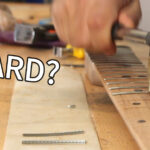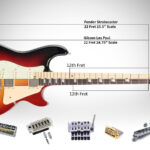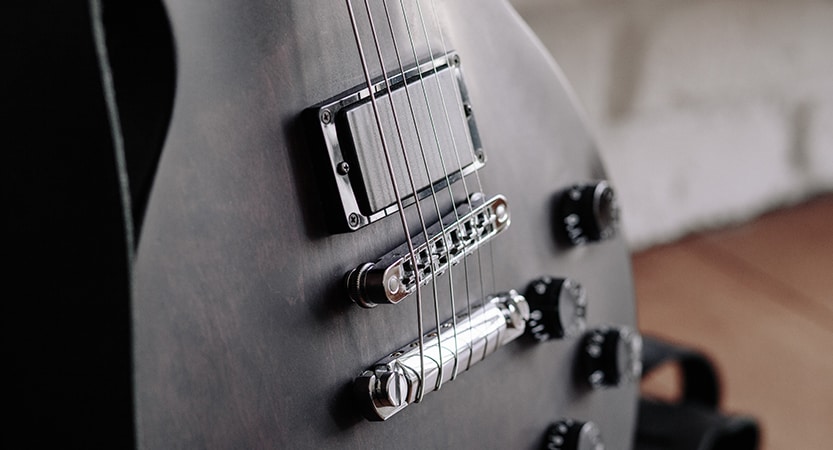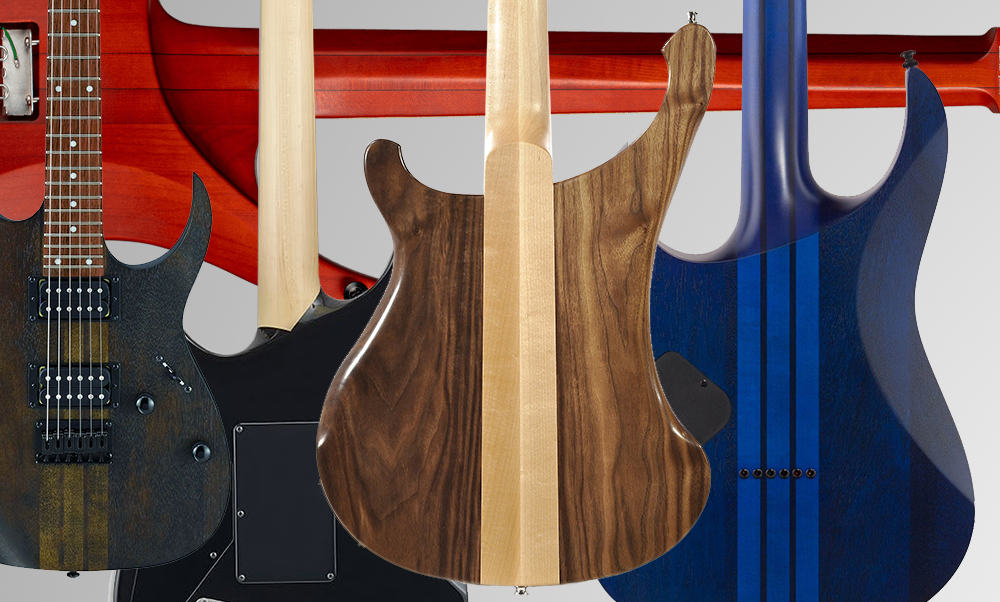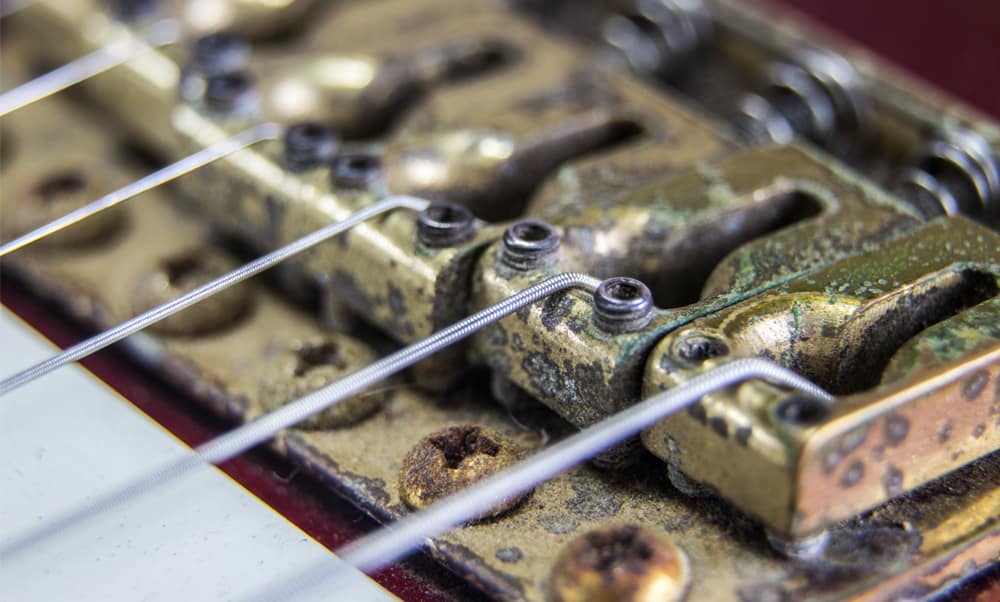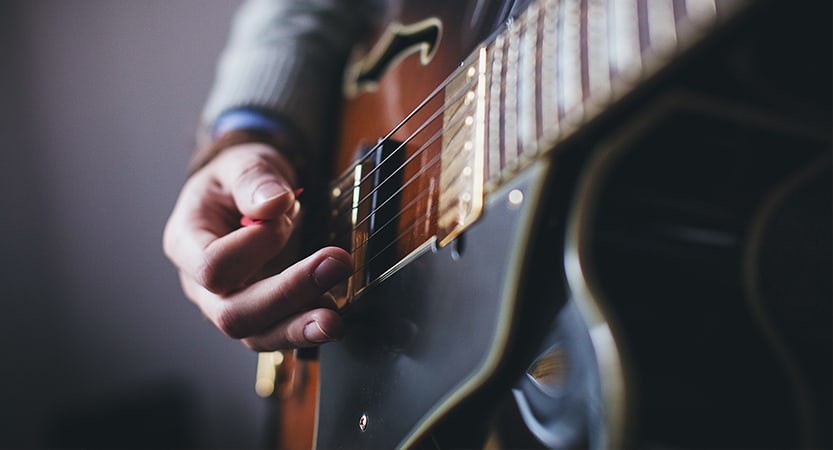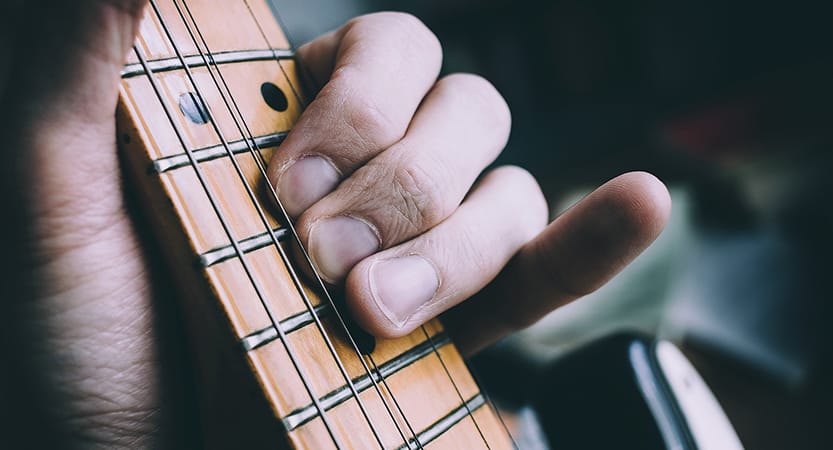The bridge of your guitar may seem minuscule in the scheme of things, but its importance mustn’t be understated. It might prove a little challenging deciding between the types of electric guitar bridges available, but we’re here to help you make the right decision.
Guitar bridges come in many varied forms, each with their own characteristics that suit different playing styles and give a different sound. However, there are 4 particular styles of the bridge which have gained popularity and are the most commonly used. These are:
- Fixed
- Tremolo
- Tune-O-Matic
- Floyd Rose
There are a lot of differences between these styles, yet some similarities all the same. It’s very important to know what makes each style so different from the other, and what the advantages to each one are. Let’s begin to discuss what makes each style so unique.
What Are the Main Types of Bridge?
A Fixed Bridge:
A fixed bridge is the most uncomplicated type of electric guitar bridge. It consists essentially of a metal plate set into the guitar’s body. The plate does not move and is fixed permanently. Apart from the string saddles, the fixed bridge has no moving parts and as such is quite suitable for beginners or less skilled guitarists although seasoned players may appreciate it for its simplicity and predictability. The saddles can be tweaked to alter the intonation of the guitar as well as its action, but these are the only moving parts on it.
The fixed bridge is also known as a ‘hard-tail bridge’, and due to the absence of complicated mechanisms, replacing strings and maintenance is comparatively simpler than the other electric bridge styles, and it remains in tune longer as well. A fixed bridge electric is a good option for rhythm guitar, which involves a lot of intermittent force on the strings. You can typically find this bridge style on Telecasters. The older Telecasters had just three saddles to adjust intonation and action, but later models, much like other newer fixed bridges, have six saddles.
The Tremolo Bridge:
A tremolo bridge, or synchronized tremolo bridge, bears a few similarities to the fixed bridge. A tremolo bridge has a metal plate with adjustable saddles, but unlike the fixed bridge, a tremolo bridge is not fixed into the guitar body. A tremolo bridge can be moved with a lever known as a ‘whammy bar’, or a ‘vibrato bar’. This bar adjusts the bridge, which in turn alters the amount of tension on the strings, changing the pitch. It is sometimes known as a ‘tremolo bar’, but that is technically incorrect as the effect it produces is not actually tremolo, but vibrato. Regardless, this term has entered standard usage.
Tuning Issues? The presence of the whammy bar allows for some rather creative effects but its mechanism, causing frequent tension changes in the strings, subjects your guitar to frequent detuning. If you’re going to be using the whammy bar a lot in your style of play, be prepared for frequent tunings to keep it sounding right. The synchronized tremolo bridge has been a staple of the Fender Stratocaster, and may be one of the reason for it’s popularity since the 60’s. It is also featured on similar styled guitars.
A Tune-O-Matic Bridge:
Similar in form to the fixed bridge, the Tune-O-Matic bridge style has its six individually adjustable saddles, but in addition to that, it has a pair of adjustable struts, one at each side of the bridge. These struts can be used to easily change the height of the entire bridge, but not dynamically during play.
The Tune-O-Matic has the very important added benefit of giving the guitarists the opportunity to adjust the saddles of each string individually. This allows for finer control of the intonation of each string. Most Tune-O-Matic guitars have the strings run up to a tailpiece, while a few of them go directly through the body.
This bridge is particularly stand-out in the way it manages to stay tuned over time. It also has excellent sustain and is a good choice if longer sustain suits your style of play. Just like the fixed bridge, the Tune-O-Matic is appropriate for beginners as it requires very little maintenance once it is up and running. The Tune-O-Matic bridge was designed and introduced by Gibson and is still synonymous with The Gibson Les Paul
A Floyd Rose Bridge:
You can think of the Floyd Rose bridge as a level above the typical synchronized tremolo bridge in terms of complexity. Instead of using a standard nut, the Floyd Rose bridge utilizes a ‘locking nut’ which helps keep the strings stationary and in tune. In addition to the locking nut, it also makes use of a locking bridge which holds the strings like a vice, with much less friction. That explains a more technical name for it: the Floyd Rose Double-Locking bridge. These two additions keep the guitar in tune longer than a guitar with a synchronized tremolo bridge. The Floyd Rose guitar bridge is patented, so only Floyd Rose and other licensed models may use it.
The Floyd Rose bridge also utilises a whammy bar, and with its double-locking system, it stays in tune a lot longer than a tremolo bridge, even with frequent use of the whammy bar. It is a complex bridge system, however, and is relatively inaccessible to beginners to guitar as maintenance is quite difficult. It should be noted though that floating Floyd Rose bridges are dependent on the tension of all strings, and a single string break will knock the whole bridge out of tune. However, a ‘half-floating’ Floyd Rose bridge does not have this problem. Floyd Rose bridges can be found most commonly on Floyd Rose guitars, but are also becoming a popular aftermarket upgrade.
Tremolo Bridges vs Fixed Bridges
We’ve talked about the different major types of bridges, of which the synchronized tremolo and fixed bridges were two of the types and perhaps the most common types of electric guitars. When purchasing a new guitar, it is an important decision to make: tremolo bridge, or fixed bridge?
For beginning or relatively unskilled guitarists, and even skilled guitarists new to electrics, the fixed bridge is a good bet. It’s the electric guitar bridge which is the most similar to the fixed bridge that is typically found on an acoustic guitar. The relatively low maintenance required and the uncomplicated mechanism of the bridge makes guitars with fixed bridges a good choice for novices. Besides, you are probably not going to use it much in the beginning anyway.
For guitarists who are advancing in skill or are comfortable around a fixed bridge electric, a tremolo bridge guitar shouldn’t be too much to handle. The introduction of the whammy bar gives a new technique to master, which is fantastic for the relatively experienced guitarist hungry for more skill. The tremolo bar opens up the opportunity to start mastering those Van Halen solos and Steve Vai riffs.
The tuning issues and relative complexity of string changes on a synchronized tremolo bridge should be easily handled by skilled guitarists but with a bit of persistence to anyone else who is keen on a whammy bar. A tremolo guitar is easy to recommend for guitarists who know their way around an electric guitar.
Locking Bridges vs Non-Locking Tremolo Bridges
An example of a locking tremolo bridge system is the Floyd Rose bridge. A locking tremolo bridge is essentially any tremolo bridge that clamps down, or locks, the strings in place. The locking nuts eliminate the sliding of the string on the nut and the changing tension on the machine heads. The advantage to using a locking tremolo bridge is that they sustain their tune a lot longer than a non-locking tremolo bridge. To get similarly consistent tuning, you would ordinarily have to look at fixed bridge guitars but a locking tremolo gives you the best of both worlds.
A non-locking tremolo bridge utilizes no locking system to hold down the strings, and as such, it loses its tuning much faster especially with frequent use of the whammy bar. Nowadays, the non-locking tremolo bridge is losing popularity due to the advantages of the locking tremolo guitar bridge over it. However, a lot of experienced guitarists still use guitars with non-locking bridges.
Despite the clear advantages of a locking tremolo bridge, there are still reasons why you might prefer a non-locking tremolo bridge over it. Guitars with non-locking tremolo bridges are generally cheaper than their counterparts and are easier to maintain because they have fewer parts.
The Classics: Telecaster Fixed and Stratocaster Tremolo vs Gibson Tune-O-Matic
Notable guitar models have notable sounds, and that means that the configuration has to remain largely unchanged. Certain models or manufacturers of guitars became known for certain types of bridges. In the same way, Floyd Rose is known for their Floyd Rose bridges, Gibson is known for Tune-O-Matic bridges, and Fender for the Tremolo bridges on their Stratocasters. Telecasters typically come with fixed bridges.You might be wondering how well Fender holds up to their major counterpart in the guitar game when it comes to their bridge types.
How do Fixed bridges and Tremolo bridges stack up the Tune-O-Matic?
The fixed bridges on the Telecaster are similar to the Tune-O-Matic bridges on the Gibson. However, the Gibson has the added advantage of being able to adjust the height of the bridge, but from the get-go, they tend to be higher than the fixed bridges on the Telecaster which some guitarists might not like. Older Telecasters had only three saddles, although the newer models have a full six, so there shouldn’t be much of an issue unless purchasing vintage. Some players prefer the Tune-O-Matic for musical styles that incorporate a lot of palm muting, as it is more comfortable to achieve. The fixed bridges are however more appropriate for the guitarist looking for a stable, reliable bridge type.
Pitting the Stratocaster tremolo bridge against the Tune-O-Matic is like comparing apples and oranges. It mostly boils down to what type of music you’re playing, and whether or not you can let go of the whammy bar. The Tune-O-Matic is easier to maintain and has relatively good sustain, but if you’re going to be needing a lot of pitch shifting in your musical styles, the tremolo might not be something you can let slide. Going for the tremolo bridge means introducing the tuning instability that comes with them, but it’s one of those cons that comes with the territory. It usually also has to do with the preference to a Strat Or a Les Paul, but that’s a different story altogether.
Electric guitar bridges differ quite considerably from one another, yet they all share similarities with each bridge picking up something from the last. It is important to learn about these bridges and understand them so that you can understand the advantages and disadvantages of each electric guitar bridge type. This will not only inform you better ahead of your next purchase but will give you a better understanding of the sound and technique of each guitar.
Ultimately, each bridge has its merits and your skill level and musical preferences have more of a say in which bridge type you end up with. There is no greatest bridge, but rather one for each player and their tastes.
Related Questions
What are the types of acoustic guitar bridges?
Acoustic guitar bridges are more easily delineated. There are two major types of acoustic guitar bridge: fixed, and floating. A fixed bridge is a panel of wood attached to the body, with a non-adjustable string saddles. A floating bridge has the strings run through a tail piece at the end, and the pitch can be altered by adjusting the saddle.
Can electric guitar bridges be replaced?
Electric guitar bridges rarely get damaged due to their metal build, but sometimes they may need replacing. Electric bridges can be replaced, and replacements can be found easily online or at your local guitar store. Bridge replacement can be a fairly straight forward task, especially if you are replacing a similar model or type. However, it can get a bit more challenging if they are not a match, and a lot more challenging if you are opting for a completely different bridge. Upgrading your tremolo from a classic Strat to a Floyde Rose Bridge will require routing the body.
How to adjust electric guitar string saddles?
String saddles are adjusted with an Allen (or hex) key. Locate the hex screws on each saddle, and turn the wrench clockwise to lift, and counter-clockwise to lower. Certain guitar models have saddles with two hex screws each, and each screw should be turned equally to maintain stability. Adjusting your saddles alters your guitar action and intonation.

